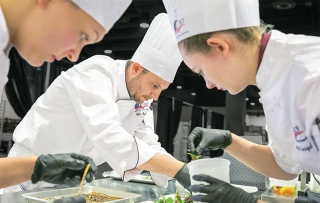
Updating the Time-honored Apprenticeship Program
03 August 2019The ACFEF updated its 40-year-old apprenticeship program in the face of changing foodservice needs and tech-savvy culinarians new to the field.
By Lisa Parrish, GMC Editor
Years ago, new culinarians gained work experience through apprenticeships that strictly followed the brigade system, usually in restaurants. Young foodservice professionals dreamed of executive chef positions within a fine dining environment.
Today’s new culinarians are not bound just to fine dining anymore. Foodservice positions are available in diverse industries from assisted living facilities to research and development kitchens of large stores to multi-billion-dollar companies such as Amazon and Facebook.
The American Culinary Federation Education Foundation (ACFEF) is responding to this changing environment by updating its apprenticeship program to reflect the changing needs of employers and workers alike. The Apprenticeship Portal, a digital learning platform designed specifically for culinary apprentices and program administrators, launched in June.
Culinarians now have three apprenticeship designations to achieve:
- Certified Fundamentals Cook at 1,000 on-the-job training hours and 90 hours of related theoretical instruction
- Certified Culinarian at 2,000 on-the-job training hours and 240 hours of related theoretical instruction
- Certified Sous Chef or Certified Pastry Culinarian at 4,000 on-the-job training hours and 420 hours of related theoretical instruction
- Certified Pastry Chef is another 4,000 on-the-job training hours designation with 445 hours of related theoretical instruction
There are pastry and savory tracks within the certifications and each level is stackable or the hours count toward the next certification. Also, the hours accrued stay with the apprentice as he or she moves throughout the foodservice industry.
Each level contains competencies apprentices are required to achieve before earning a certificate. A new program feature allows for some or all of what was once classroom or theoretical instruction to be completed via online ACF sources. This flexibility allows for industries such as Workforce Development programs to create specialty apprenticeship programs, according to Jason Neff, ACF culinary program associate. “This was one of the biggest surprises for us (interest in the program from Workforce Development teams). It’s astounding. But, people are looking for ways to be able to help their communities,” he said.
The Apprenticeship Portal’s online flexibility has caught the eye of many new potential apprenticeship host programs. Jean McElwain, ACF apprenticeship administrator, said that ACFEF received 18 new applications for apprenticeship programs in the last several months, which is more than they have received in the past several years. One highlight for program sponsors is an ability to incorporate industry-specific training through the apprentice program’s elective options.
Neff explains, “We can customize and build competencies depending on what they (the host program) do. For example, we are working with a research and development kitchen of a large convenience store chain. They are interested in food science and sensory evaluation. We accomplished this by adding in those competencies in the creation process.”
McElwain said that a new apprenticeship site can be up and running in as little as two and a half months by efficiently following a 10-step program. The first step is to establish a committee that determines the apprenticeship scope. Other steps include identifying employment placement options, determining the method of related theoretical instruction, scheduling a site visit and recruiting and placing apprentices.
“During the program creation, the business or entity chooses the source for instruction,” McElwain said. “It could be the online courses from the ACF Learning Center or through a cultural arts program (educational institution).” She also noted that the instruction for Certified Fundamentals Cook is typically the information taught in high school culinary courses and that those hours may count toward the certificate’s required 90 hours of classroom instruction.
Apprentices in the program work in a foodservice environment while completing the competencies under the watchful eye of a supervising chef, which is set out by the apprenticeship host program. ACFEF’s Apprenticeship Portal has modernized this relationship by creating an online environment easily accessible by the student, supervising chef and apprenticeship coordinator. The apprentice logs his or her hands-on hours directly into the portal via a smart phone or computer. The portal also records skill competencies associated with training tracks and can be used to review subject knowledge pages via the Learning Center. This system replaces the manual method of tracking skills and competencies through logbooks and binders.
Neff described an example of how the portal may be used: “If you have an apprentice who is working on a line and made a bechamel sauce, they could quickly take a picture with their phone and upload it to the portal to show competency for that skill. Then the supervising chef could (log into the portal and) review the picture to approve the competency.”
These efficiencies have helped reduce the number of training hours from a previous high of 6,000 hours to 4,000 hours now required for the Certified Sous Chef level, according to Neff.
ACFEF’s apprenticeship program is registered with the US Department of Labor who, with the help of ACF chefs and culinary educators, set the designation’s competency standards. All three of the designated levels are expected to be approved by the Department of Labor by fall. By the end of 2019, all 1,000 ACFEF apprentices will be migrated to the new Apprenticeship Portal.
To learn more about the American Culinary Federation and ACFEF apprenticeship, including how to start or enroll in a program, visit acfchefs.org.
